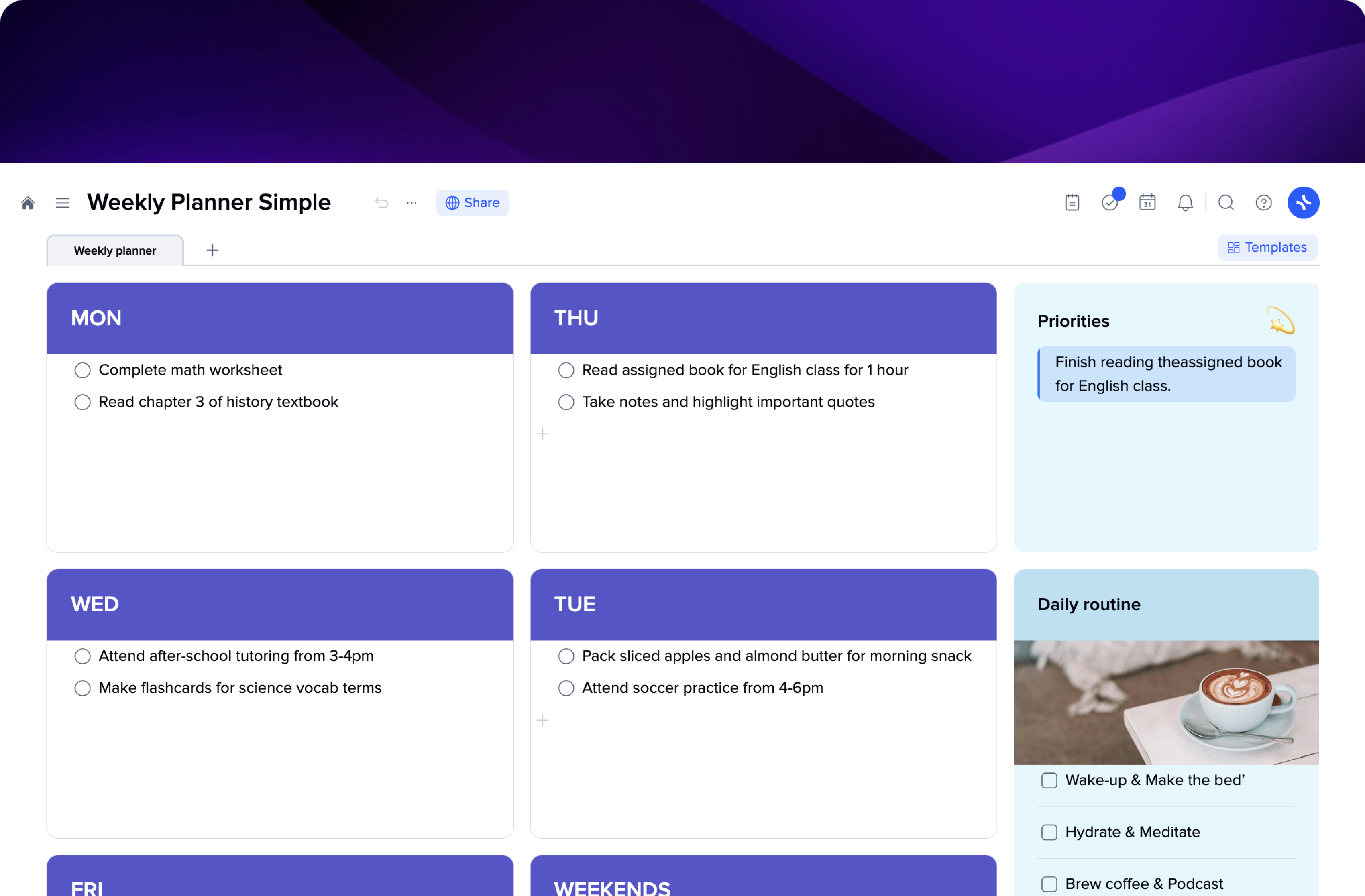Event Agency
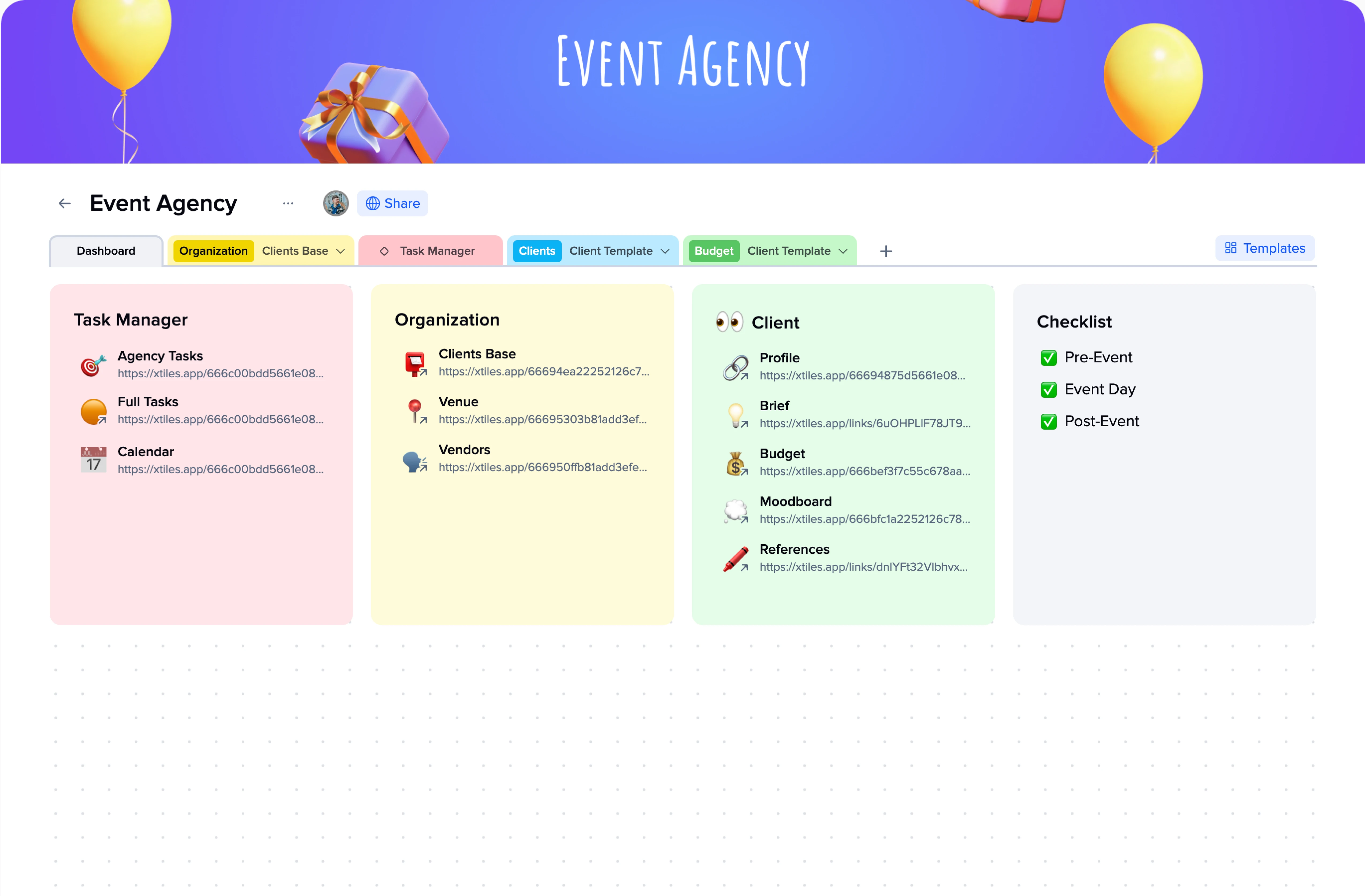

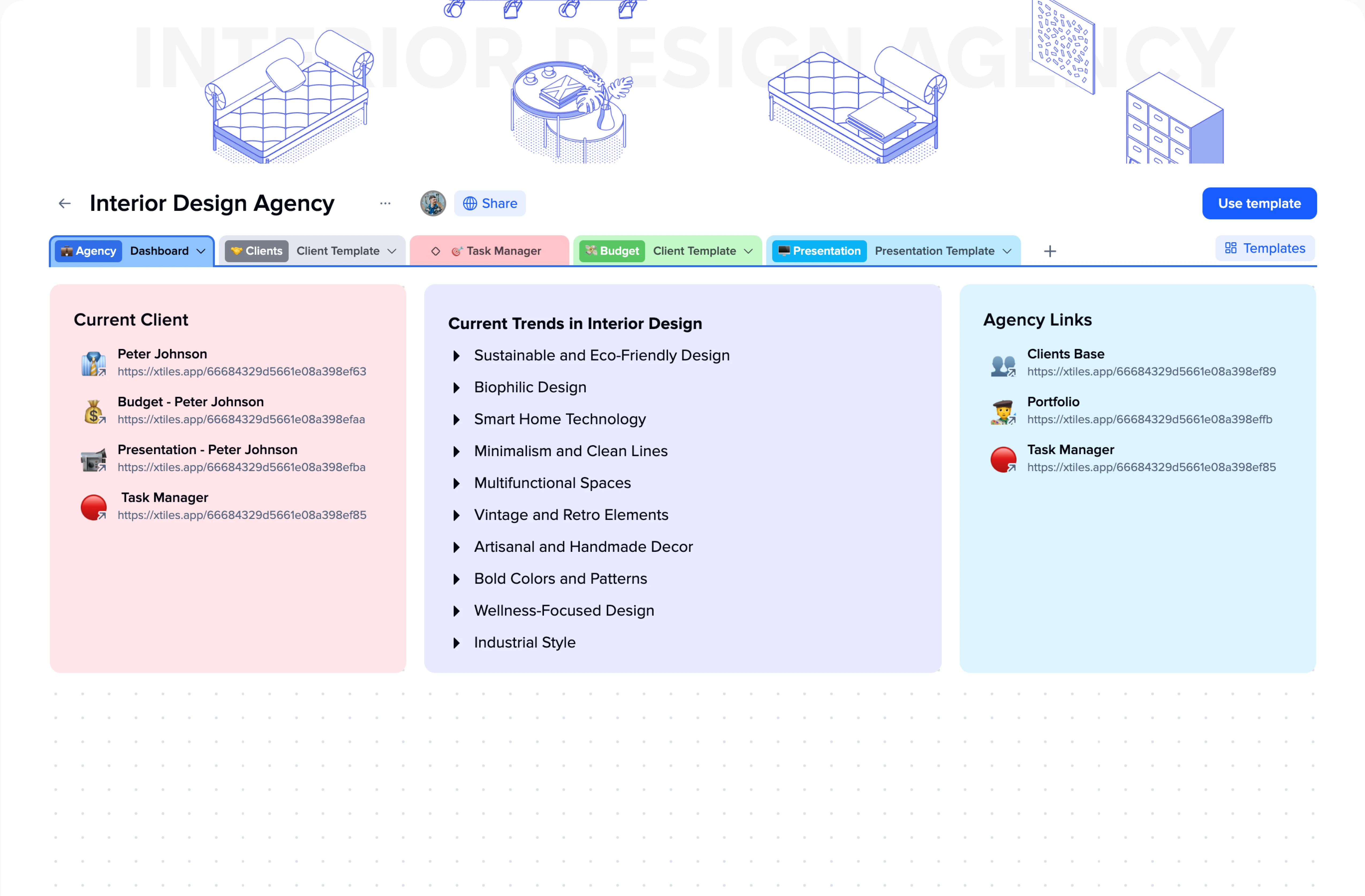
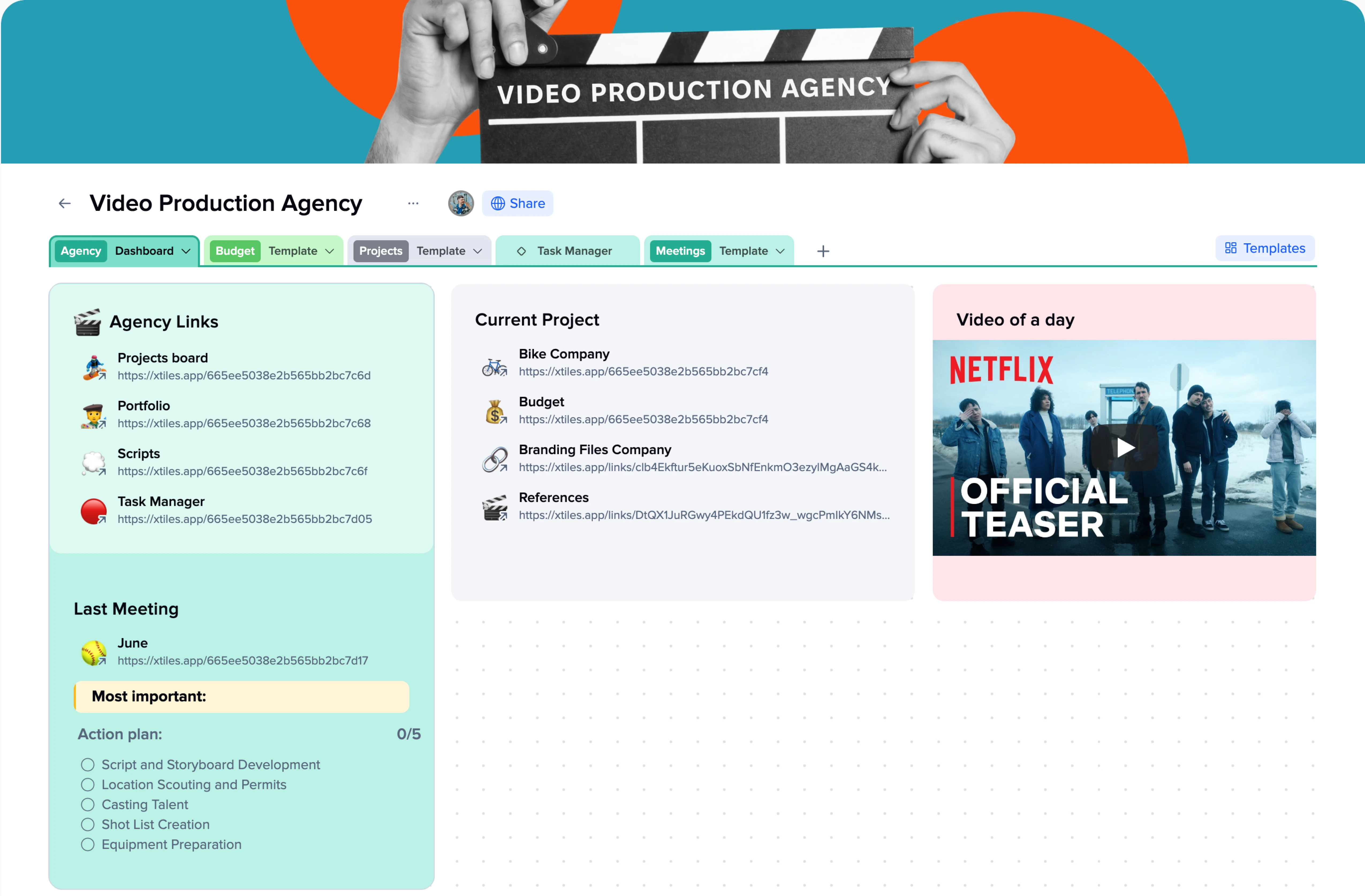
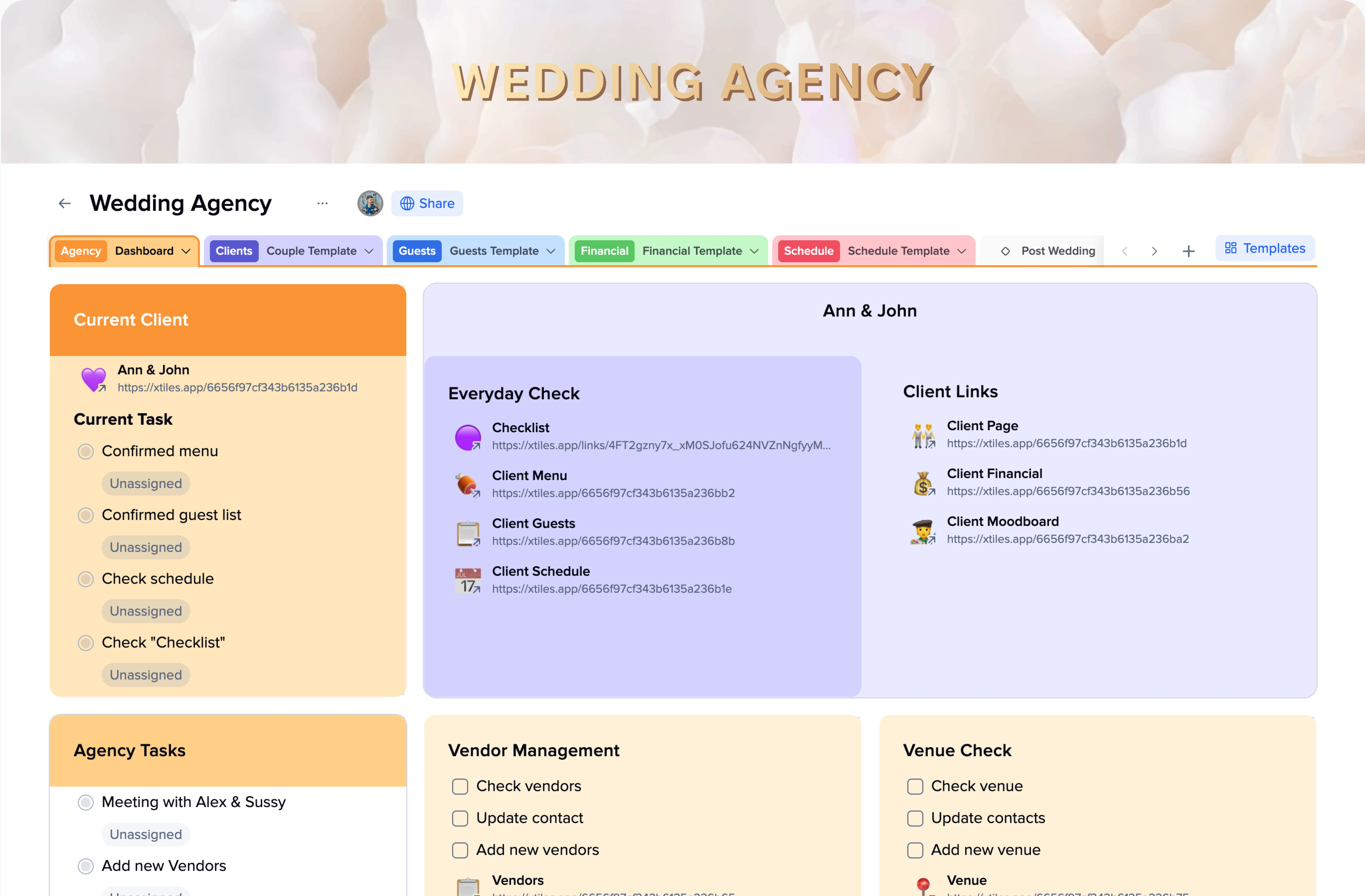
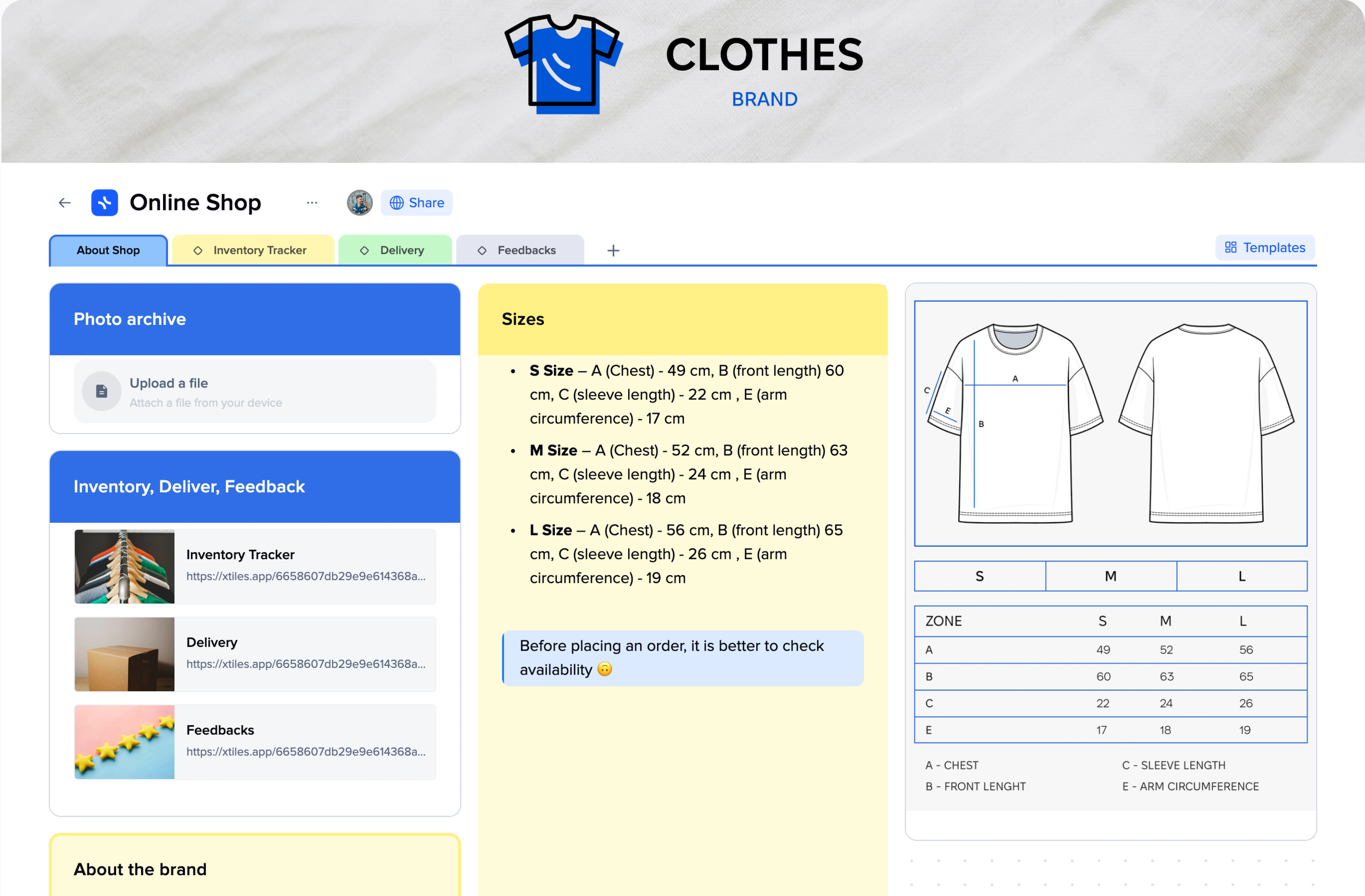
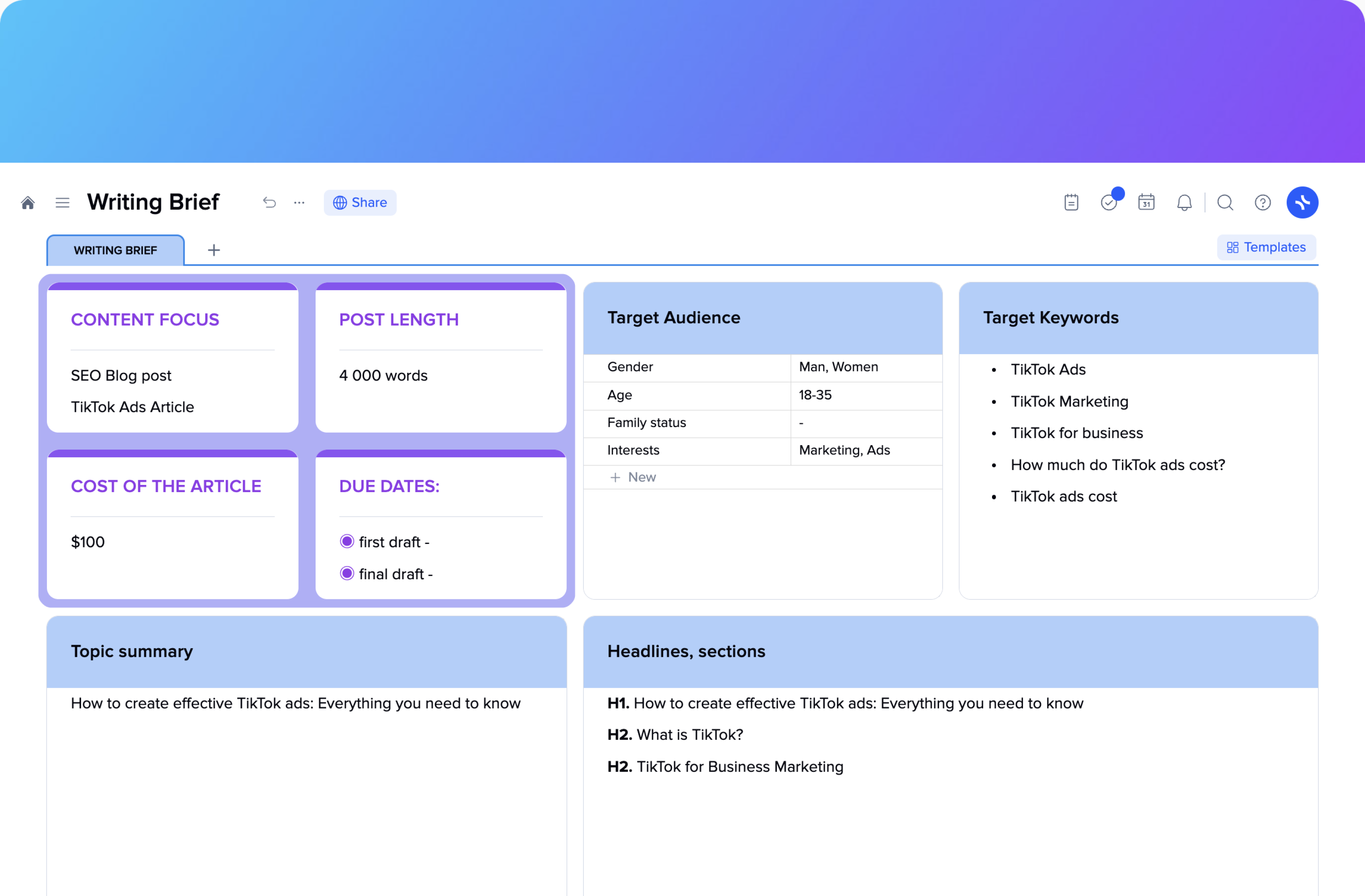
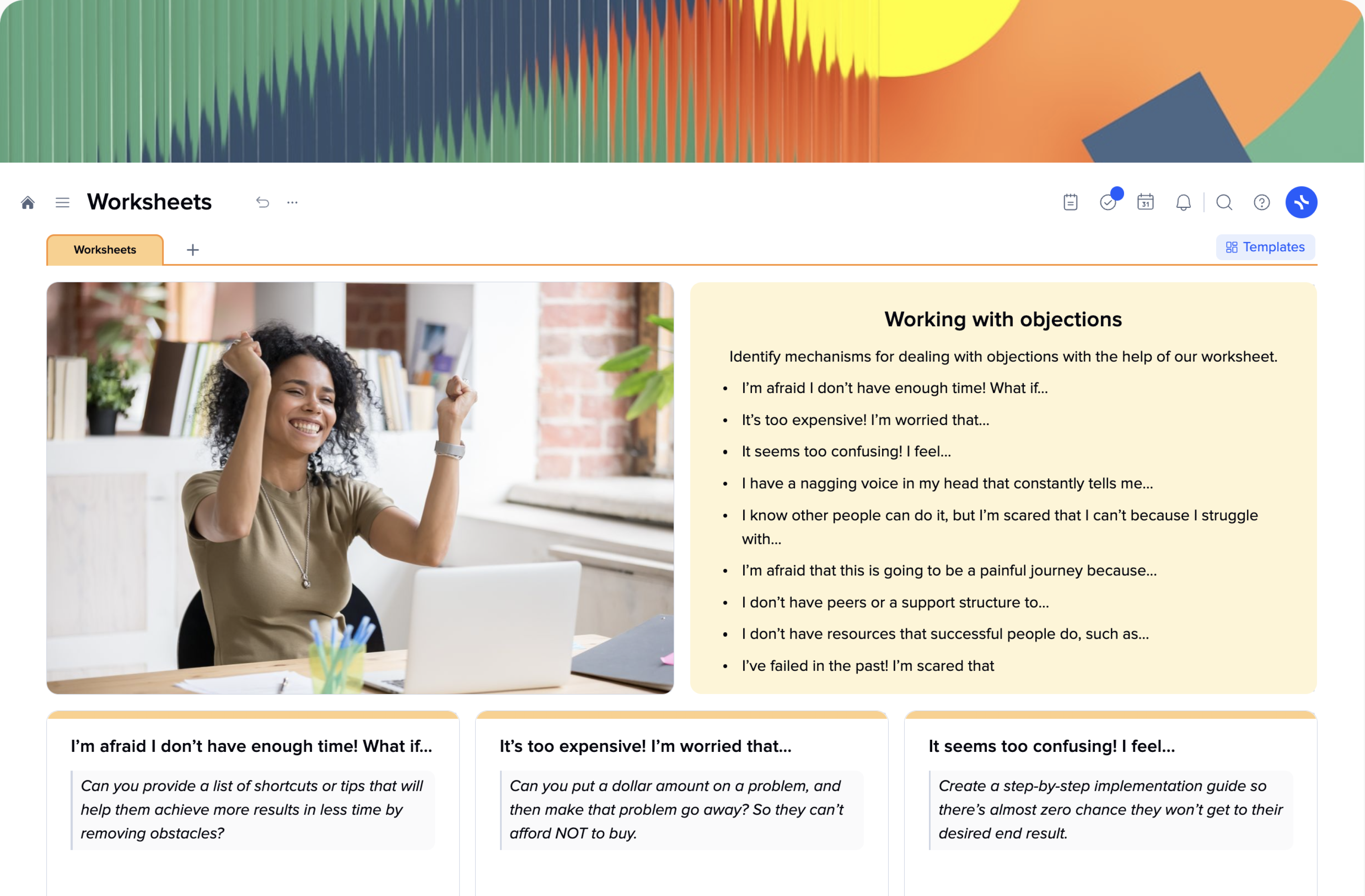

How often have you ever wondered what would be a perfect gift for your friend or significant other? How often has their mysterious phrase “you can buy me whenever you want” driven you crazy? How many times did you wish people could better understand you without words?
Wish lists make your life and your loved ones’ lives easier and spare you awkward explanations of what you would like to get as a present. You give your guests a list of what you would like to get and sleep soundly. That helps people save their time looking for the best present and help them plan their budget.
A wish list template is a tool for quick and easy organizing of desired items. The xTiles Wish List Template is great for collecting items you want to get/buy, whether you will use it for helping your guests to decide on the present or for yourself, tracking your wishes, and motivating yourself.
In addition to the ready-to-use customizable wish list template, we also offer a quick guide on how to create your own personalized wish list and a couple of ideas on what to include in your list when you have no ideas but still need to provide your guests with references.
Creating wish lists is a popular and efficient method for tracking the items you want to purchase or receive as gifts. Whether you’re compiling these lists for special occasions like weddings or birthdays or simply for personal use, wish lists serve as valuable tools for organizing your thoughts, simplifying the shopping process, and ensuring that you and others can clearly understand your preferences.
At their core, wish lists are like curated catalogs filled with the things that captivate your desire or longing. You have the freedom to add any gift you come across, whether it’s discovered in a physical store or found online.
Wish lists have multiple purposes, driven by various motivations. One common reason is personal organization, as individuals use wish lists to keep track of future purchases they intend to make. By documenting these desired items, you create a centralized repository that helps you stay organized and focused on your shopping goals.
By creating and sharing your list, you can guide friends, family members, and attendees of special events on the types of gifts you’d truly appreciate. This eliminates guesswork and ensures that the gifts received align with your preferences and needs.
Whether you’re hosting a celebration or simply want to provide gift suggestions, wish lists, and registries serve as valuable resources for those who wish to find the perfect present for you.
To create a wishlist, you can use any list-making tool or platform that suits your preference. Many online retailers offer wish list features that allow you to add items and keep them organized easily.
Alternatively, you can use dedicated wish list applications, wish list makers, or a wish list template to jot down the items you desire. The flexibility of wish list templates enables you to generate them for multiple purposes, whether it’s keeping a record of your desired purchases, sharing gift ideas with others, or even inspiring and motivating yourself to work towards acquiring those items in the future.
In summary, by creating and utilizing wish lists, you can enhance your shopping experience and ensure that your desires are effectively communicated to others.
A registry is a bit similar to a wish list but with the distinction that it is maintained by a store and made publicly accessible. Registries are normally used for special occasions like weddings, birthday parties, and anniversaries.
This list is accessible to the public, allowing friends, family, and other occasion attendees to view and choose items from the registry they wish to gift. After someone purchases an item from the registry, it is typically marked as fulfilled or unavailable to avoid duplicates.
A registry provides a clear and organized selection of items the recipient genuinely desires, reducing the guesswork and ensuring that the gifts align with their tastes and needs. Additionally, registries save time and effort for guests, as they can easily access the registry, select an item within their budget, and confidently contribute a gift that will be appreciated.
Why do individuals create wish lists? Well, there are multiple reasons behind this common practice, and none of them has anything to do with vain or greed. A wish list is a simple way to say what present you would like to get, especially when it’s hard to speak about such matters and say your desires out loud.
Except for that, wish lists offer people the following:
Wish lists greatly facilitate online shopping, making it simpler to browse and purchase desired items, especially if your list has all the needed links.
By creating a wish list, people can effectively keep track of items they plan to purchase in the future. It serves as a centralized location to store and manage their desired products.
Wish Lists, also known as registries, play a crucial role in occasions like hosting a function or celebration. They enable individuals to communicate their preferred gifts to friends, family, and attendees, making the gift-buying process much easier. It eliminates guesswork and ensures that recipients receive presents they truly desire.
Wish lists are not solely restricted to immediate purchases. They can serve as a collection of items that individuals aspire to own in the future, even if they are currently unaffordable. By creating a wish list, individuals can retain a record of their desires and aspirations, providing inspiration and motivation to work towards acquiring those items over time.
Every specific occasion needs its specific wish list. Even though they serve the same purpose – providing attendees with a list of desired items, many different kinds exist. Let’s explore some of the most common types:
A Christmas wish list, probably one of the most popular, is a compilation of items individuals would like to receive as gifts during the holiday season.
That’s also one of the first wish lists children learn to create, asking Santa Clause for the desired staff. So, its role is pretty huge, and it may become a valuable tool for parents to establish a special connection with their kids.
People of all ages create these lists, and they serve as helpful guides for family members, friends, and loved ones when selecting presents. The items included can range from toys and games to clothing and gadgets, reflecting personal preferences and interests.
A Secret Santa wish list may be considered as a subspecies of a Christmas wish list. While your loved ones at least know at which section of a store to go to find you a present, people playing Secret Santa, as a rule, know nothing about whom they need to make a gift. That’s why such a list helps everyone, and sometimes it’s a must for attendees. To simplify attendance, the person who takes care of the whole endeavor may ask attendees to use a wish list template.
A birthday wish list is a collection of items an individual would like to receive as gifts for their birthday celebration. Similarly to a Christmas wish list, people of all ages can create wish lists for their birthdays.
Birthday wish lists are a helpful reference for family, friends, loved ones, and all the guests seeking gift ideas. The items on the list can span a wide range, from books and music to electronics and experiences, tailored to the recipient’s interests and preferences.
A wedding registry, also known as a wedding wish list, is a compilation of desired gifts a couple creates in preparation for their wedding. This list assists family members and friends select appropriate gifts for the couple.
Items included in a wedding registry can encompass a broad spectrum, ranging from kitchen appliances and bedding to honeymoon experiences and even contributions towards a down payment on a home. Essentially, anything available for purchase can be added to a wedding registry.
Once the registration process is complete, the couple can share their wedding registry with guests through email or social media.
A baby shower registry is a curated list of items expectant parents desire or require for their upcoming arrival. Parents-to-be or a close friend or family member typically create this registry to guide baby shower guests when selecting gifts.
Many people use standardized baby shower registry lists as the collection of items newborn and new parents need doesn’t significantly vary.
Today, creating a wish list is easier than ever before with all the available apps, tools, and templates. In today’s digital era, digital wish lists or registries are increasingly popular, which is no wonder. Allowing people to easily create lists, customize and edit whenever they want, digital wish lists have become widely used in many situations and occasions, and industries.
The xTiles Wish list Template is a quick and easy way to collect all the items you want/plan to purchase, organize them depending on their categories, and share them with anyone who may be interested in making you a gift. So, let’s start!
Also, it’s important to decide on price ranges if you’re creating a wish list for guests.
Wish lists are here to simplify lives for our guests. However, sometimes they may become quite a conundrum for those who have to compile them. That’s why we gathered some ideas of what you may add to your wish list when you have zero ideas but still want to receive something nice.
Experiential gifts have become incredibly popular these days. From thrilling skydiving adventures and luxurious dining experiences to indulgent spa days, these gifts are favored because they offer more than just a physical item, they offer everlasting memories.
Here’s your chance to witness something you’ve always dreamed of if you add some events you would like to attend to your wish list.
Now that the Pandemic has almost no power over our lives and the world reopens, events as gifts are making a strong comeback. Artists, athletes, and performers are returning to stadiums, theaters, and clubs, allowing you to see your favorite musicians, sports teams, or inspiring TED Talks.
When you include event gifts in your wish list, you immerse yourself in the things you love, going beyond material possessions to experience the magic of live performances.
Knowledge is a gift that lasts a lifetime, and as many individuals pursue new hobbies and interests during the lockdown, the thirst for knowledge continues to grow.
It’s delightful to see the growing trend of adding classes to wish lists. People strive to learn new things and skills. The joy of discovery and the eagerness to learn are thriving.
People are embracing lessons to enhance their skills in painting, pottery, salsa dancing, public speaking, guitar playing, learning different languages, and everything they dreamed about but never had the gut to try.
Wish lists also can be set up for housewarming events and farewell parties for those moving abroad, for example. In other words, you can put on your wish list ordinary and everyday things, not only something big and great.
Additionally, you’re free to use their wish lists to efficiently organize their weekly shopping needs and necessities. However, a common shopping list may be more suitable for your daily needs.
Have you ever experienced the feeling of receiving a gift that doesn’t quite match your preferences? Trying to express gratitude and excitement might be a tough task when you unpack something you don’t want. And that is one more reason why it’s safer to create wish lists before celebrations.
It can be challenging to find the perfect gift for someone. To make the shopping experience easier and take control of your own gifts, you may include vouchers from your favorite stores on your wish list.
With vouchers, you’ll never have to fake excitement for a gift that misses the mark. Even if your preferred store has a limited selection for the season, vouchers often have a longer expiration date, allowing you to choose something you truly desire.
This one is quite self-explanatory, but there are many things that people hesitate to buy for themselves, considering them too extravagant or inappropriate to purchase on their own. This often applies to pampering gifts or luxurious items like high-quality jewelry or pricey devices.
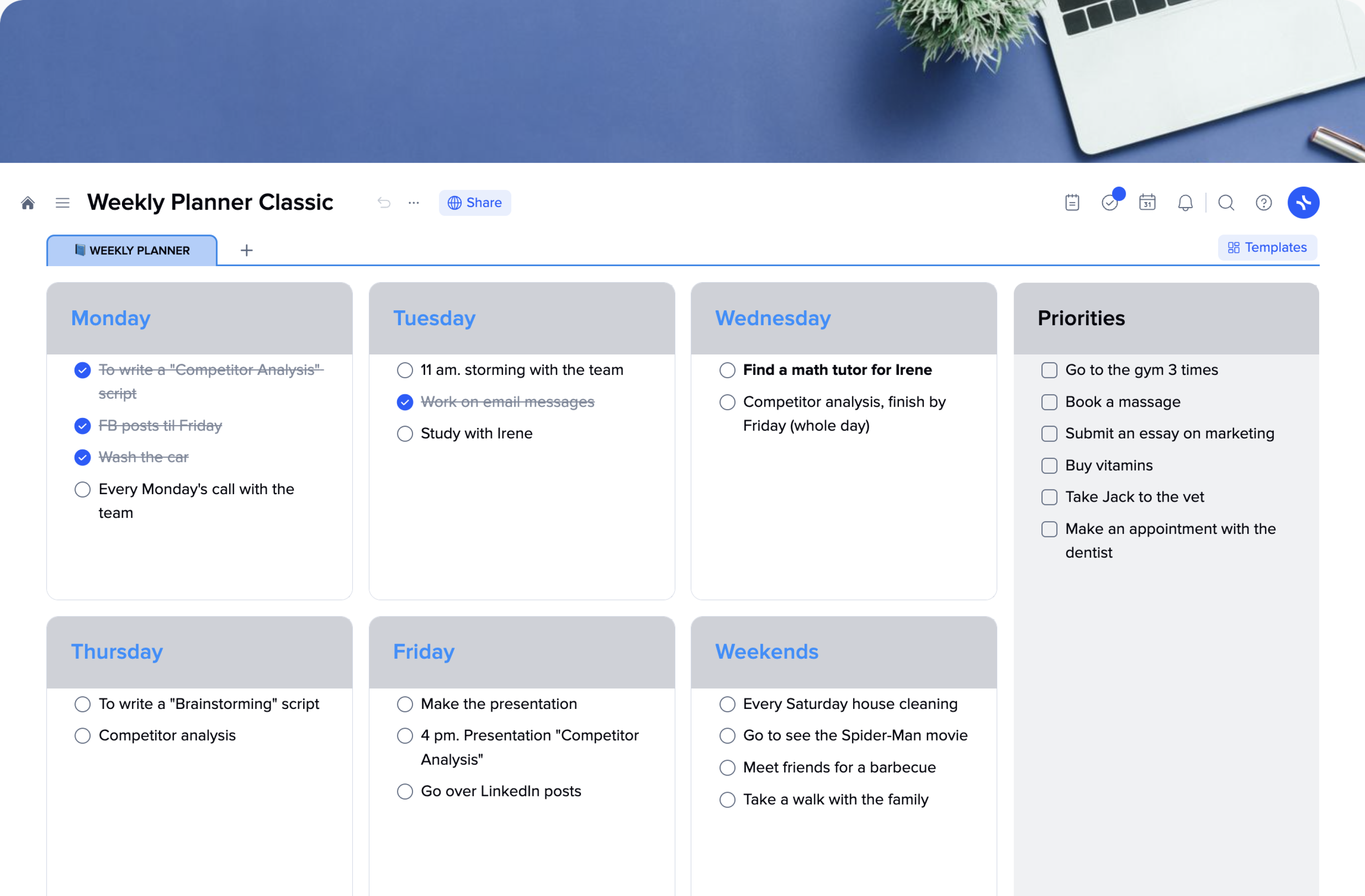
Writing everything down in a notebook? Using notes on the phone? Or sticky notes all over your fridge or work desk? Or perhaps you try to keep everything in mind, hoping you won’t miss anything important? These are old-school approaches. At some point, they were good, and they still might be useful for certain cases. However, the pace of the modern world demands us to be flexible yet productive. Forgotten tasks or missed deadlines return as a boomerang, ruining the workflow we intended to build.
Starting to plan your week might be hard. There will be so many questions, and even more of them will arise once you start. And coming up with a workable approach straight away might be impossible, especially for a person who has never done anything like that before. So, we have a solution for you.
xTiles week planning template is easy to use, easy to implement in any routine, and easy to customize regarding your specific needs and lifestyle if needed. You may keep it in your virtual workspace, share it with anyone who should be informed about your plans, print it, and keep it at your desk.
A weekly schedule planner is, broadly speaking, your schedule embodied, whether on paper or virtually. It can be of different sizes, structures, and designs. Some people call one long list of all tasks put together a planner. For some, this concept is more complicated. Their planner may look like 7 seven lists, one for every day of the week, gathered in one place. For some, it is enough only to briefly name their tasks, while others prefer to specify what exactly they are intended to accomplish.
As you can see, the concept of a weekly planner is quite broad and differs from case to case, often leading to misunderstandings. Usually, other people’s planners are undiscovered soil with its own organization and structure. And when we need to synchronize our tasks or schedule our time with them, we might get stuck with “translating” what their planner is about.
That’s why weekly planning templates are so great for teams and those who spend time together. For example, xTiles weekly planner offers you an easy-to-understand and work-with structure, leaving space for your customization and improvisation. While it’s standardized, it may still be unique and represent you not only because of your tasks.
We prepared for you a weekly planner template where we combined what is inevitable and deleted what is unnecessary and might distract you from attaining progress during a week. It’s divided into days, with each of them having certain tasks. Also, we understand that not all tasks can be accomplished in one day. Some of them require more time, so in our weekly planner template, you will find a place for your long-term but still weekly tasks. Also, to have everything important in hand, we added a shopping list, your daily-routine tracker, and a place for some pictures or other graphic elements to inspire you.
Somehow, there’s still the idea that weekly planning templates aren’t for everyone. You must have a super busy lifestyle to benefit from one. Indeed, they are to make your life easier and take the burden of memorizing everything. However, even if you don’t have to attend dozens of meetings every day, you still may need one.
When was the last time you forgot to buy milk while buying a full bag of useless stuff? When was the last time you forgot to wish your granny a happy birthday? Or have you ever asked someone to remind you to do something later, and they forgot about it too? Weekly planners are for avoiding these kinds of accidents.
Here are the most common situations where a good weekly planner may be a life-changer.
And remember that
The right answer to that question would be “as you wish”. No one can decide what you should do with your planner. However, we dare to share our own experiences and what we came up with working on our weekly planning template.
As we already mentioned, a weekly plan is very personal. It can say a lot about its owner. It shows whether you like to get done with the longest and hardest tasks at once or postpone them. It represents your style, when is your most productive time, etc. Well, your planner will represent all of these if it’s created correctly and regarding your needs and situation. Otherwise, it not only won’t work, it probably will annoy and slow you down.
Office workers are usually involved in corporate planning, whether they want it or not, while their personal lives might stay utterly hectic. Why is this so? The first and foremost reason is that their companies use a weekly work planning template that is inconvenient and causes more stress than profit. The experience they’ve gotten is negative, so they rely on their memory because no planner at all may seem to them better than a bad one. However, there are hundreds of free weekly planning templates, and there’s definitely at least one for you.
We already went over almost all the most important aspects of a successful weekly planner. The core idea we want to share is that a weekly planner is a great way to relax a bit without affecting your daily tasks and routine. And a weekly planner template is a great way to ease the whole process.
Now, let’s finish with a few last suggestions on how you can make a weekly plan that will work for you.
